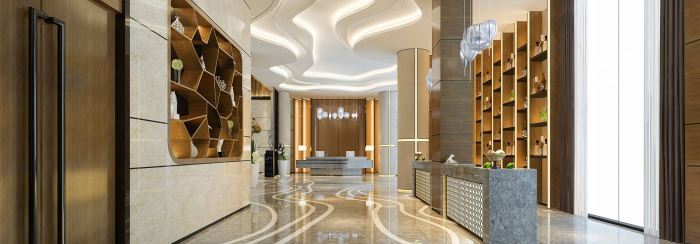Crafting the Perfect Lobby Interior Design: Key Elements and Innovations

Embark on a journey through the realm of lobby interior design, where every element plays a crucial role in shaping the first impressions of visitors. From functional design elements to aesthetic touches, we delve into the world of creating inviting and captivating commercial spaces.
As we explore the significance of lobby interior design, the key elements that define a well-designed lobby, and showcase successful examples across diverse industries, the allure of these spaces comes to life.
Overview of Lobby Interior Design
When it comes to commercial spaces, the lobby serves as the first point of contact for visitors, making it a crucial area for making a lasting impression. Lobby interior design plays a significant role in creating a welcoming atmosphere, reflecting the brand identity, and setting the tone for the overall experience.
Key Elements of a Well-Designed Lobby
- Layout: A well-designed lobby should have a functional layout that allows for easy navigation and flow of traffic.
- Lighting: Proper lighting is essential to create ambiance and highlight key features in the lobby.
- Furniture and Decor: The choice of furniture and decor should align with the brand aesthetic and provide comfort to visitors.
- Color Scheme: Colors have a significant impact on the mood and perception of a space, so choosing the right color scheme is crucial.
- Branding Elements: Incorporating branding elements such as logos, colors, and signage helps reinforce brand identity.
Examples of Successful Lobby Interior Designs
Successful lobby interior designs can be found across various industries, each showcasing unique elements that cater to their specific needs:
- Hotel Industry: Luxury hotels often feature grand lobbies with high ceilings, elegant furnishings, and intricate lighting designs to create a sense of opulence and luxury.
- Tech Companies: Tech companies like Google and Apple opt for modern and innovative lobby designs with interactive features, vibrant colors, and unique artwork to reflect their cutting-edge image.
- Healthcare Facilities: Hospitals and medical centers focus on creating calming and welcoming lobbies with comfortable seating, soothing colors, and nature-inspired elements to reduce stress and anxiety for patients and visitors.
Functional Design Elements
Functionality plays a crucial role in lobby interior design as it directly impacts the overall user experience and efficiency of the space. A well-designed lobby should not only be visually appealing but also practical and user-friendly.
Importance of Lighting
Lighting is a key element that can greatly enhance the ambiance of a lobby. Proper lighting can create a welcoming atmosphere, highlight architectural features, and guide visitors through the space. Whether it's natural light from windows or strategically placed artificial lighting, the right lighting design can make a significant difference in how the lobby is perceived.
Role of Furniture Layout
The layout of furniture in a lobby is essential for creating an inviting and comfortable environment for visitors. Carefully placed seating areas, tables, and other furniture pieces can help define different zones within the lobby, such as waiting areas, reception desks, or meeting spots.
The furniture layout should encourage social interaction, provide comfort, and facilitate circulation throughout the space.
Aesthetic Design Elements

When it comes to lobby interior design, aesthetic elements play a crucial role in creating a welcoming and visually appealing space for guests. From color schemes to textures and decorative elements, every detail contributes to the overall look and feel of the lobby.
Impact of Color Schemes
Color schemes have a significant impact on the ambiance of a lobby. Warm tones like beige, gold, and earthy hues can create a cozy and inviting atmosphere, while cool tones like blues and greens evoke a sense of calm and relaxation
Bold and vibrant colors can add a touch of modernity and energy to the space. The careful selection of colors can set the tone for the entire lobby design and influence the mood of visitors.
Textures and Materials
Textures and materials play a vital role in adding depth and character to the lobby design. Incorporating materials like wood, stone, glass, and metal can create a rich and sophisticated look. Textures such as plush carpets, sleek marble floors, or rough stone walls can add tactile interest to the space.
By combining different textures and materials, designers can enhance the visual appeal of the lobby and create a multi-dimensional experience for guests.
Decorative Elements
Decorative elements like artwork, plants, or sculptures can elevate the aesthetic appeal of a lobby. Artwork can serve as a focal point and inject personality into the space, while plants bring a touch of nature and freshness. Sculptures can add a sculptural element and serve as conversation starters.
By incorporating these decorative elements thoughtfully, designers can enhance the overall aesthetic of the lobby and create a memorable experience for visitors.
Technology Integration
Technology integration in lobby design plays a crucial role in creating a modern and efficient space that enhances the overall visitor experience. By incorporating various technological elements, such as digital displays, interactive kiosks, smart systems for lighting, temperature control, and security, lobbies can become more functional, aesthetically pleasing, and engaging for guests.
Incorporation of Digital Displays and Interactive Kiosks
One of the key ways technology is integrated into lobby design is through the use of digital displays and interactive kiosks. These elements can provide important information to visitors, such as event schedules, building maps, or company announcements, in a visually appealing and easily accessible manner.
Interactive kiosks can also offer self-service options for check-ins, wayfinding, or accessing additional resources, improving efficiency and convenience for guests.
Smart Systems for Lighting, Temperature Control, and Security
In modern lobby designs, smart systems are often implemented to control lighting, adjust temperature settings, and enhance security measures. These systems can be programmed to automatically adjust lighting levels based on natural light conditions or occupancy, maintaining a comfortable and energy-efficient environment.
Similarly, temperature control systems can regulate heating and cooling based on occupancy patterns, ensuring a pleasant atmosphere for visitors. Additionally, advanced security technologies, such as facial recognition or access control systems, can enhance safety and provide a seamless entry experience for guests.
Enhancing Visitor Experience through Technology
Technology can greatly enhance the visitor experience in a lobby setting by offering interactive and personalized features. For example, virtual concierge services or touch-screen directories can provide assistance and information to guests, creating a more welcoming and engaging environment. Furthermore, integrating elements like digital art displays or multimedia installations can add a creative and dynamic touch to the space, leaving a lasting impression on visitors.
Final Conclusion
In closing, lobby interior design stands as a testament to the fusion of functionality and aesthetics, where technology seamlessly integrates to elevate the visitor experience. From color schemes to smart systems, every detail contributes to crafting unforgettable first impressions in commercial settings.
Commonly Asked Questions
How important is lighting in lobby interior design?
Lighting is crucial as it sets the ambiance and mood of the space, influencing how visitors perceive the environment.
What role does furniture layout play in creating an inviting lobby?
The layout of furniture can determine the flow of movement and comfort for visitors, impacting their overall experience.
How can technology enhance the visitor experience in a lobby setting?
Technology integration can provide interactive elements, improve efficiency, and offer a modern touch to engage visitors effectively.

